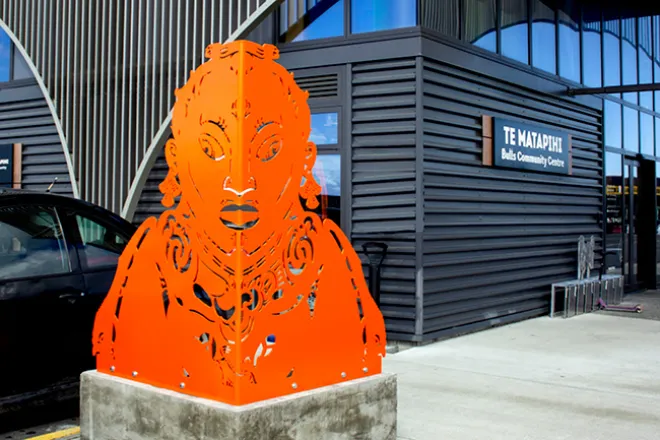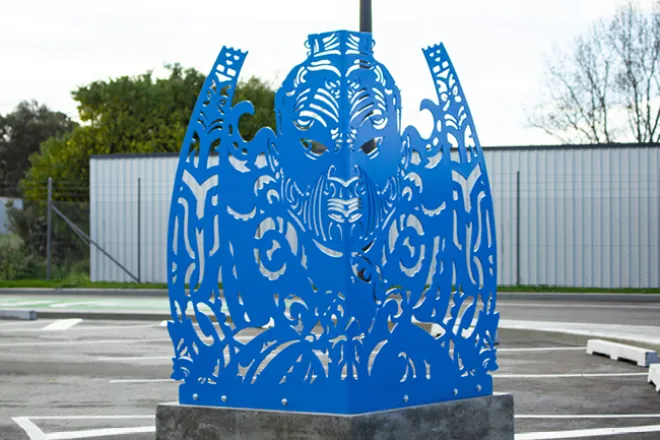Te Matapihi - Artwork
The art installations at Te Matapihi are a joint project between Rangitikei District Council and local iwi/hapū.
There are two local iwi/hapū involved in this process Ngā Wairiki Ngāti Apa and Ngāti Parewahawaha (Ngāti Raukawa).
It was originally decided that artworks within the building would be done by Ngā Wairiki Ngāti Apa who contracted Len Hetet to do that work. The artwork outside the building would sit with Ngāti Parewahawaha and they contracted Reweti Arapere and Pip Devonshire to do this.
The artworks are superb and tell the story of the surrounding district, highlighting for example the awa - Rangitīkei River and the associated iwi. The artworks are contemporary in nature and design and sits incredibly well with the design and function of Te Matapihi.
Head along to Te Matapihi - Bulls Community Centre to check out the work in real life.
Read more about the art and artists below:

Te Matapihi
The name ‘Te Matapihi’ was gifted to the Bulls Community Centre by Ngāti Parewahawaha and Ngā Wairiki-Ngāti Apa.
Bring us together under the umbrella of peace.
Where the land rolls into the ancestral waters of the Rangitīkei
We acknowledge you Papatuānuku (earth mother)and Ranginui (sky father). To nourish us, to sustain us, and bring us together as people.
The pattern represents the Rangitīkei land plains and the Rangitīkei river. It shows the coming together of people and the connection to the land and waterways. The koru patterns above and below represent Ranginui and Papatuānuku to which we as Māori connect physically and spiritually
Our tohu has been specifically created for Te Matapihi by Len Hetet (Ngāti Apa, Ngāti Tūwharetoa, Ngāti Maniapoto, Te Āti Awa).
Parewahawaha Manawaroa
These artworks are from Ngāti Parewahawaha, commissioned by the Rangitīkei District Council, created by Pip Devonshire (Ngāti Parewahawaha, Ngāti Manomano, Ngāti Te Au).

Parewahawaha Manawaroa Art Installation
The name of these three artworks is ‘Parewahawaha Manawaroa’.
Their stance is that of resilience against the winds of adversity. Their cloaks are in miro, a two ply technique weavers apply to muka whenu (flax fibre warp threads). The evenness of miro depends upon the balanced nature of the twist applied to the threads as they are individually rolled downwards and together, back up the weavers leg. If the twist is tensioned too tightly the miro becomes lumpy and uneven, generally not wanted in weaving.
The two threads in miro are representative of the Treaty of Waitangi obligations between Māori and the crown.
Individually each drawing is for Ngāti Parewahawaha mana whenuatanga (those having mana over their immediate rohe) drawing inspiration from pepeha.
- ‘Ko Rangitikei te Awa’ shows water flows of various natures affected by seasonal changes and states of health.
- ‘Ko Ōhinepuhiawe te Whenua’ undulates with swollen bellies carrying babies nurtured within their whenua (placenta), rich with depth, clothed in the cloak of Tane, juxtaposed with the bare fields of hair.
- ‘Ko Ruahine te Pae Maunga’ hair is as we see the ranges today, yesterday and into the future with the bedrock or tuapapa giving us a sure and sound foundation into the future.
Ko ‘Parewahawaha Manawaroa’ te ingoā o ngā mahi toi e toru nei.
Ko tā rātou tū, anō nei e kaupare ana i nga hau pūkeri. Ko ō ratou kākahu, he miro, he mahi nā te kaiwhatu e tāmirotia ai ngā whenu muka e rua. Ko ie papatairite rānei o te miro ka ahu mai i te pīrori tika o ngā whenu, heke takitahi whakararo i te waewae o te kaiwhatu, ka hoki ngātahi whakarunga mai. Mēnā ka kikī rawa te tāmiro, ka pukupuku te āhua o te miro, tē hiahiatia i ngā mahi whatu. Ka whakaari mai ngā whenu e rua i nga hononga i waenga i Ngāi Māori me te karauna i raro i Te Tiriti o Waitangi.
Ko tā ia tuhinga he whakaari mai i te mana whenua o Ngāti Parewahawaha, i ahu mai i tōna pepeha.
- ‘Ko Rangitīkei te awa’ e whakaari ana i rere o te wai me ngā pānga o nga kaupeka o te tau me te ora o te wai.
- E kitea ana i roto o ‘Ko Ōhinepuhiawe te whenua’ he whenua raorao e pupuhi ana ki ngā pēpi e whakatupuria ana i roto i te whenua, he rerehua, he rētō. E kākahuria ana ki te kahu o Tāne, e tū tauaro ana me nga pātiki wātea i roto i ngā makawe.
- I roto i ngā makawe o ‘Ko Ruahine te Pae Maunga’ ka kitea te pae maunga o te rā nei, o nanahi, o āpōpō hoki, hei tūāpapa mo te anamata o te iwi.
Te Pou o Parewahawaha & Te Pou o Kupe
Artist: Reweti Arapere
Reweti Arapere (b.1984) is an artist and illustrator, from Ngāti Parewahawaha, Ngāti Raukawa,Tuwharetoa, and Ngāti Porou. Reweti has a Master of Māori Visual Arts from Toioho ki Apiti School of Maori Studies, Massey University. Arapere has exhibited extensively both throughout Aotearoa New Zealand and internationally.
He works primarily in illustration, painting, sculpture and installation, his practice bringing together traditional Māori narratives and artistic practices with contemporary materials and forms.

Te Pou o Parewahawaha
Medium: Mild steel and polyester thermosetting paint.
The first of these two artworks welcome everyone at the main entrance of Te Matapihi.
This piece is a representation of tupuna kuia Parewahawaha, a reminder that if you follow the road down past Te Matapihi you will arrive at Parewahawaha marae.
The orange colour of this pou is inspired by the orange wattle of the Huia. The huia is a revered taonga for Māori and symbolises the leadership and mana of this tupuna.
The feathers from the tail of the huia were also particularly prized and also adorn the ears of this figure.

Te Pou o Kupe
Medium: Mild steel and polyester thermosetting paint.
The second sculpture situated at the south entrance of Te Matapihi is a representation of Kupe the navigator from
Te Taitokerau. Henare Toka and Mere Toka lead the building of Parewahawaha and were from Te Taitokerau. There is a wheke (octopus) depicted on either side of Kupe. This wheke is what lead Kupe across the Pacific Ocean to Aotearoa.
The blue colour of this pou alludes to the colour of Te Moana nui a Kiwa (Pacific Ocean).
These two sculptures act as markers in the landscape acknowledging the whenua Ohinepuhiawe and the powerful
force of the Rangitīkei River. Both sculptures stand strong upon the whenua grounding this interpretation of whakairo (carving) and figurative symbols. Their folded forms are designed to represent the tauihu or bow of a waka taua (war canoe). Bridging modern and customary histories, these figures demonstrate how our narratives continue to guide Māori cultural identity today.
